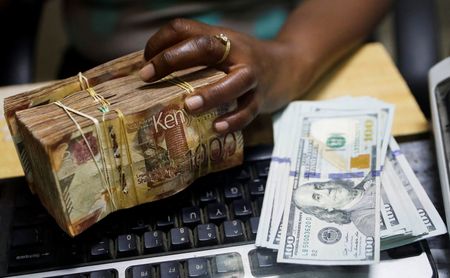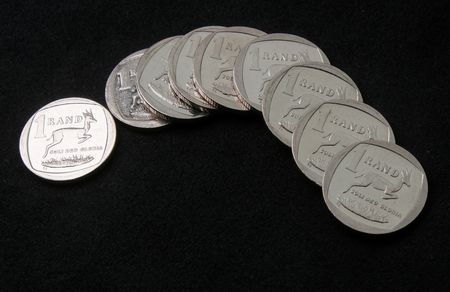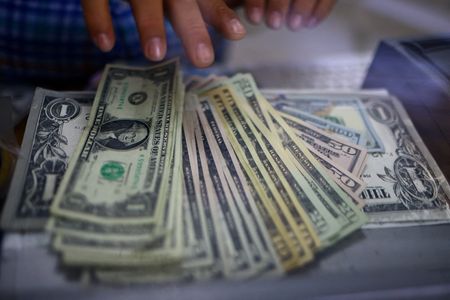By Stefano Rebaudo
(Reuters) – The U.S. dollar held its ground on Tuesday as President Donald Trump’s tariff threats were interpreted more as a negotiating tactic rather than an end goal, a day after he suspended planned measures against Mexico and Canada.
However, the new Trump administration imposed additional 10% tariffs on imports from China from 12:01 a.m. ET on Tuesday (0501 GMT) and currency analysts said they expected high sensitivity to tariff developments and volatility to persist.
The U.S. dollar index, a measure of the value of the greenback relative to a weighted basket of six major foreign currencies, was roughly unchanged at 108.5 while the Canadian dollar and Mexican peso weakened, after Monday’s rebound.
The euro also declined slightly, with Washington threatening that the European Union may be next in line for trade levies, which are widely expected to push up U.S. inflation, supporting the dollar by keeping U.S. interest rates higher for longer.
“That Trump wants to negotiate is clear,” said Marcus Widén, an economist at SEB.
“But at the same time, there is a basic idea that tariff revenues should finance tax cuts, and from that perspective, one could wonder if one can go back on tariff plans every time.”
Beijing on Tuesday imposed tariffs on some U.S. imports in a swift response to new U.S. duties on Chinese goods, raising the stakes in a showdown between the world’s top two economies.
“Overall, the (Chinese) measures are relatively modest,” said Lee Hardman, senior currency analyst at MUFG.
“It suggests that China is wary of pushing back too hard against Trump’s latest tariffs and is leaving the door open for future negotiations,” he added, recalling that the 10% tariff hike for China could just be the first step for China after Trump threatened to raise tariffs as high as 60%.
Analysts also flagged that it will be hard for China and the U.S. to agree on what Trump demands.
The Chinese yuan edged down about 0.15% to 7.2914 per dollar in offshore trading. There is no official yuan trading until Wednesday, with mainland markets still closed for the week-long Lunar New Year holidays.
The Australian dollar, which often acts as a liquid proxy for the yuan because the Australian economy is highly exposed to China, fell 0.35% to $0.6206, well above Monday’s low of $0.6085, the weakest level since April 2020.
EURO LOWER
The euro slid 0.15% to $1.033, with market participants watching parity.
“The maximum trade war risk premium seen during the first Trump administration was six big figures which would take the euro/dollar to parity,” said George Saravelos, head of forex research at Deutsche Bank.
“A European Central Bank (terminal rate) repricing down to 1.50%, with the Fed (policy path) unchanged, would take the euro/dollar further down to 0.98-0.99 based on current betas.”
Several analysts recently said that U.S. tariffs would have a deflationary effect on the euro area.
Money markets increased their bets on ECB rate cuts on Monday, pricing in a depo rate at 1.85% in December from 1.95% late on Friday. They are currently discounting 1.9%.
The Canadian dollar lost 0.15% to C$1.4428 against its U.S. counterpart, following a sharp rebound from a low of C$1.4792 on Monday, the weakest level since 2003.
The Mexican peso dropped 0.23% to 20.380, after jumping over 1.5% the day before.
The pound edged lower against the euro after recording its biggest daily rise in three months as investors expect U.S. tariffs to hurt the economy more in Europe than in the UK.
The U.S. dollar gained 0.38% to 155.31 yen, with the Japanese currency seen as a safe-haven currency and the greenback less appealing after recent rises.
(Reporting by Stefano Rebaudo; Editing by Sonali Paul, Kim Coghill, Sharon Singleton and Alexander Smith)









